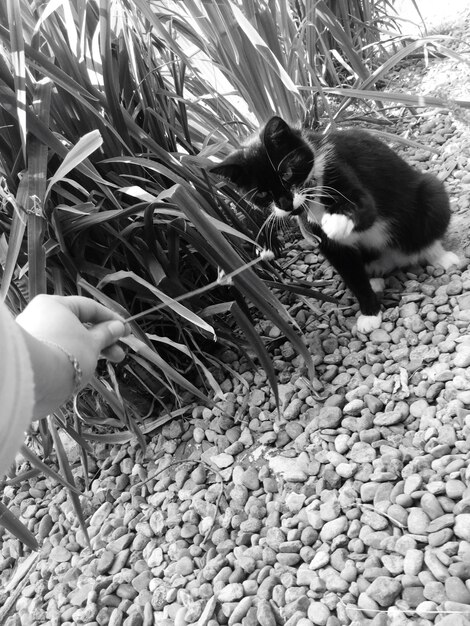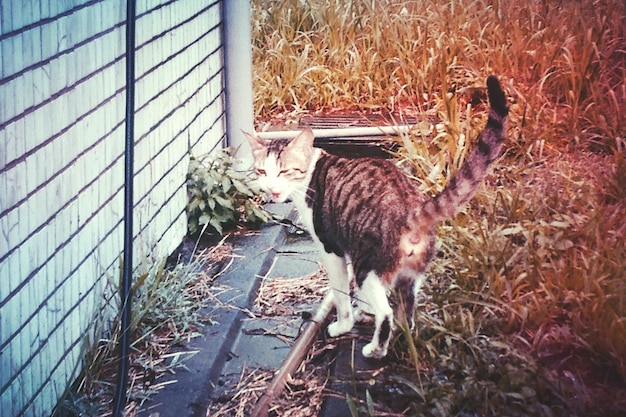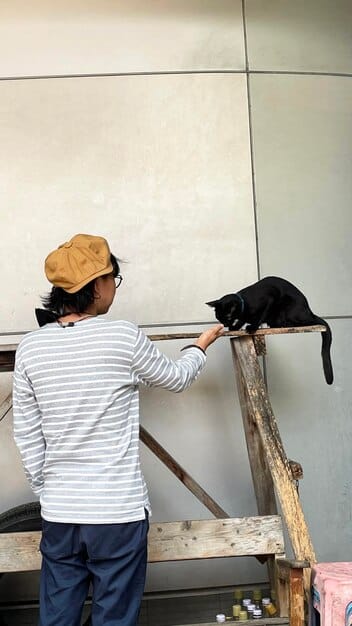Implement TNR Programs: Reducing Feral Cat Populations in US Communities

Implementing Trap-Neuter-Release (TNR) programs is a humane and effective strategy for managing and reducing feral cat populations in US communities by trapping, sterilizing, vaccinating, and returning cats to their territories.
Across the United States, communities grapple with the challenges posed by feral cat populations. Implementing Trap-Neuter-Release (TNR) programs offers a compassionate and proven method to manage and reduce these populations, benefiting both the cats and the communities they inhabit.
Understanding Feral Cat Populations
Feral cat populations are a common sight in many US communities, often misunderstood and facing numerous challenges. Understanding their origins, behaviors, and the impact they have on the environment is crucial for developing effective management strategies.
Feral cats are domestic cats that have reverted to a wild state, either through abandonment or having been born into the wild. Unlike stray cats, which are socialized to humans and can often be re-domesticated, feral cats are generally fearful of humans and prefer to avoid contact.
Origins of Feral Cat Colonies
Feral cat colonies typically form when unspayed or unneutered domestic cats are abandoned or allowed to roam freely. These cats then reproduce, and their offspring become feral. This cycle continues, leading to a rapid increase in the cat population.
Behavioral Characteristics
Feral cats exhibit distinct behaviors that differentiate them from pet cats. They are often nocturnal, hunting and scavenging for food. They form social structures within their colonies, with hierarchies and territories that they defend. Their primary goal is survival, which often leads to behaviors that are perceived as problematic by humans.

The environmental impact of feral cat populations is significant. As opportunistic hunters, they prey on native wildlife, including birds, small mammals, and reptiles. This can disrupt the delicate balance of ecosystems and contribute to the decline of certain species. In urban environments, feral cats can also be a nuisance, causing property damage and spreading diseases.
Understanding these aspects of feral cat populations is the first step towards implementing effective and humane management strategies, with implementing Trap-Neuter-Release (TNR) programs being one of the popular methods used in managing the feral cat population.
What is Trap-Neuter-Release (TNR)?
Trap-Neuter-Release (TNR) is a humane and effective method for managing feral cat populations. It involves trapping feral cats, sterilizing them, vaccinating them against common diseases, and then returning them to their original territories.
The TNR process is straightforward but requires careful planning and execution. Trained volunteers or animal control professionals trap the cats using humane traps. These traps are designed to minimize stress and injury to the cats. Once trapped, the cats are taken to a veterinarian or a spay/neuter clinic.
- Trapping: Humane traps are used to capture feral cats. The traps are baited with food to lure the cats inside.
- Neutering or Spaying: Sterilization prevents further reproduction, helping to control the population.
- Vaccination: Cats are vaccinated against diseases like rabies and feline leukemia.
- Ear-Tipping: A small portion of the left ear is surgically removed, serving as a visual indicator that the cat has been sterilized.
- Release: The cats are returned to their original territories, where they continue to live out their lives.
TNR programs offer several benefits. By sterilizing feral cats, TNR prevents further population growth. This reduces the number of cats competing for resources and minimizes the strain on local ecosystems. Vaccinating the cats also helps to prevent the spread of diseases, protecting both the cats and the community.
For example, Alley Cat Allies, a leading advocacy organization for cats, states that TNR is the most humane and effective method for controlling feral cat populations. Many local animal shelters and rescue organizations have successfully implementing Trap-Neuter-Release (TNR) programs to reduce feral cat populations in their communities.
Benefits of Implementing TNR Programs
Implementing TNR programs offers a wide range of benefits to both the feral cat populations and the communities in which they live. By controlling population growth, reducing nuisance behaviors, and improving the overall health and welfare of the cats, TNR provides a compassionate and effective solution to the challenges posed by feral cat colonies.
One of the most significant benefits of TNR is the reduction in population growth. Feral cats can reproduce rapidly, with a single female cat capable of producing multiple litters per year. Sterilization through TNR prevents this uncontrolled breeding, leading to a gradual decline in the number of feral cats over time. This not only reduces the strain on local resources but also minimizes the potential for conflict between cats and humans.
Reduced Nuisance Behaviors
Unsterilized cats often exhibit behaviors that can be disruptive and annoying to humans. These behaviors include spraying, fighting, and loud vocalizations, especially during mating season. TNR can significantly reduce these nuisance behaviors by eliminating the hormonal drives that trigger them.
Improved Cat Health and Welfare
TNR programs typically include vaccinations and veterinary care, which can improve the overall health and welfare of feral cats. Vaccinations protect against common diseases, while medical treatment can address injuries or illnesses. This helps to ensure that the cats live healthier and more comfortable lives.
A study by the American Society for the Prevention of Cruelty to Animals (ASPCA) found that TNR programs can lead to a significant reduction in shelter intake and euthanasia rates. By preventing the birth of unwanted kittens, TNR reduces the number of cats entering shelters, freeing up resources for other animals in need.
Successful TNR programs often involve collaboration between local animal shelters, rescue organizations, and community volunteers. These partnerships can provide the resources and expertise needed to effectively manage feral cat populations. The benefits of such collaborations are undeniable when implementing Trap-Neuter-Release (TNR) programs.

Steps to Implementing a TNR Program
Implementing a TNR program requires careful planning, coordination, and community involvement. From conducting a colony assessment to establishing partnerships and ensuring ongoing monitoring, each step is crucial for the success of the program.
The first step in Implementing Trap-Neuter-Release (TNR) programs is to conduct a thorough assessment of the feral cat colonies in the area. Identify the size and location of the colonies, as well as any unique challenges or concerns. This information will help to guide the development of the TNR program and allocate resources effectively.
- Conduct a Colony Assessment: Identify the size and location of feral cat colonies in the area.
- Establish Partnerships: Collaborate with local animal shelters, rescue organizations, and veterinarians.
- Secure Funding: Explore grant opportunities, fundraising events, and individual donations.
Establishing partnerships with local animal shelters, rescue organizations, and veterinarians is essential for the success of a TNR program. These organizations can provide expertise, resources, and support. Veterinarians can offer discounted spay/neuter services, while shelters and rescue groups can assist with trapping and post-operative care.
Securing funding is a critical aspect of implementing a TNR program. Spay/neuter surgeries, vaccinations, and veterinary care can be costly. Explore grant opportunities from animal welfare organizations, host fundraising events, and seek individual donations from community members.
Creating a trapping schedule and ensuring the humane capture of cats is a crucial step in Implementing Trap-Neuter-Release (TNR) programs. Work with experienced trappers to develop a schedule that minimizes stress to the cats and avoids disrupting their natural behaviors. Use humane traps that are designed to capture cats without causing harm.
After surgery, the cats need a safe and quiet place to recover before being returned to their colonies. Coordinate with local shelters or rescue groups to provide post-operative care. Ensure that the cats have access to food, water, and a clean litter box during their recovery period.
Challenges and Solutions in TNR Programs
Implementing TNR programs can present various challenges, from gaining community support to managing logistical hurdles. Addressing these challenges requires proactive planning, effective communication, and creative problem-solving.
One of the most common challenges in implementing TNR programs is gaining community support. Some people may be opposed to the idea of returning feral cats to their neighborhoods, while others may be concerned about the cats’ impact on wildlife.
Addressing Community Concerns
To address community concerns, it is essential to educate the public about the benefits of TNR. Explain how TNR can reduce feral cat populations, minimize nuisance behaviors, and improve the health and welfare of the cats. Share success stories from other communities that have implemented TNR programs.
Funding and Resource Constraints
Funding and resource constraints can also be significant challenges. Spay/neuter surgeries, vaccinations, and veterinary care can be costly, and many TNR programs operate on limited budgets. Seek out grant opportunities from animal welfare organizations, host fundraising events, and partner with local businesses to secure donations.
Another challenge is the logistical complexity of trapping, transporting, and caring for feral cats. Trapping can be time-consuming and labor-intensive, while transporting cats can be stressful for both the cats and the volunteers. Provide training to volunteers on proper trapping techniques and animal handling procedures. Consider using mobile spay/neuter clinics to bring veterinary services directly to the cats’ colonies.
For instance, a local animal shelter in Austin, Texas, implemented a TNR program that included community outreach and education. They held public forums to address concerns and provided training to volunteers, resulting in a successful reduction in feral cat populations. TNR programs implementing Trap-Neuter-Release (TNR) programs are all aimed at achieving this goal.
The Future of TNR in US Communities
The future of TNR in US communities looks promising, with increasing recognition of its effectiveness and humane approach to managing feral cat populations. As more communities embrace TNR and implement comprehensive programs, the positive impact on both cats and communities will continue to grow.
The increasing recognition of TNR as a best practice for managing feral cat populations is driving its adoption in more communities across the US. Local governments, animal shelters, and rescue organizations are recognizing the benefits of TNR and incorporating it into their animal management strategies.
- Increased Recognition: TNR is increasingly recognized as a best practice for managing feral cat populations.
- Technological Advancements: Technological advancements are improving the efficiency and effectiveness of TNR programs.
- Community Engagement: Community engagement is essential for the long-term success of TNR programs.
Technological advancements are also playing a role in the future of TNR. GPS tracking devices can be used to monitor the movements of feral cats, helping to identify new colonies and assess the impact of TNR programs. Remote-controlled traps can be used to capture cats in hard-to-reach areas. Data management software can streamline record-keeping and track the progress of TNR efforts.
Community engagement is essential for the long-term success of TNR programs. Educating community members about the benefits of TNR, involving them in trapping and monitoring efforts, and encouraging responsible pet ownership can help to create a more compassionate and sustainable approach to managing feral cat populations.
In conclusion, Implementing Trap-Neuter-Release (TNR) programs continues to evolve, adapting to new challenges and opportunities. By building partnerships, leveraging technology, and engaging communities, TNR can create a brighter future for feral cats and the communities they inhabit.
| Key Point | Brief Description |
|---|---|
| 🐾 TNR Definition | Trapping, neutering, and returning feral cats to their colonies. |
| 💰 Funding TNR | Grant applications, community fundraising, and individual donations. |
| 🤝 Partnerships | Collaborate with local shelters and veterinary professionals. |
| 👂 Community Education | Address concerns and demonstrate TNR results. |
Frequently Asked Questions
▼
TNR is humane because it reduces feral cat populations naturally over time, avoids euthanasia, and improves the lives of existing cats. Sterilized cats also exhibit reduced nuisance behaviors.
Trap-Neuter-Release reduce feral cat population size effectively?
▼
Yes, studies show that when TNR efforts spay or neuter a significant percentage of the cat population, it reduce new birth, stabilize, or decrease its initial size over time.
How can community members help with TNR programs?
▼
Community members can help by volunteering to trap cats, donating to support spay/neuter costs, and helping monitor released cats. They can also educate their neighbours.
Does TNR address the environmental impact of feral cats?
▼
How long does it take to see results from a TNR program?
▼
The impact of a TNR program on a feral cat population size is often not immediately apparent, but is usually observed within approximately 3 to 5 years after the initiation of TNR.
Conclusion
Implementing Trap-Neuter-Release (TNR) programs offers a humane and effective solution for managing feral cat populations in US communities. By embracing this community-driven approach, it protects both the cats and the neighborhood they live in.





